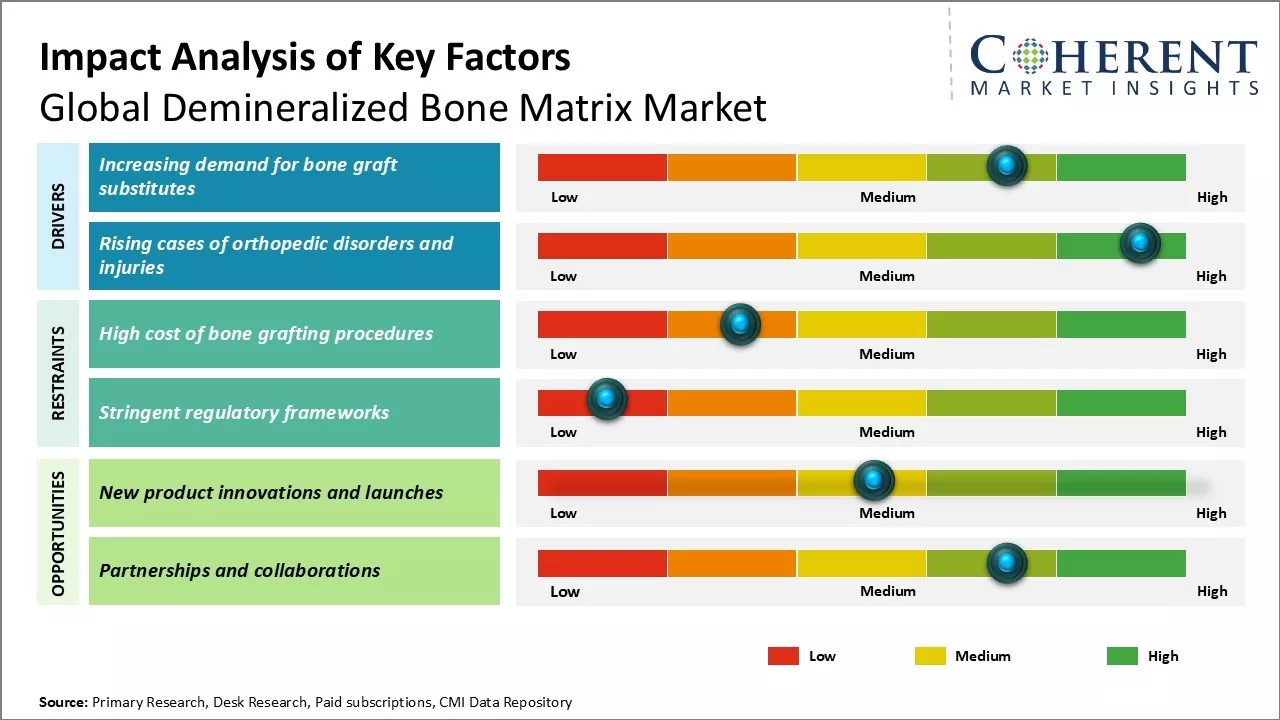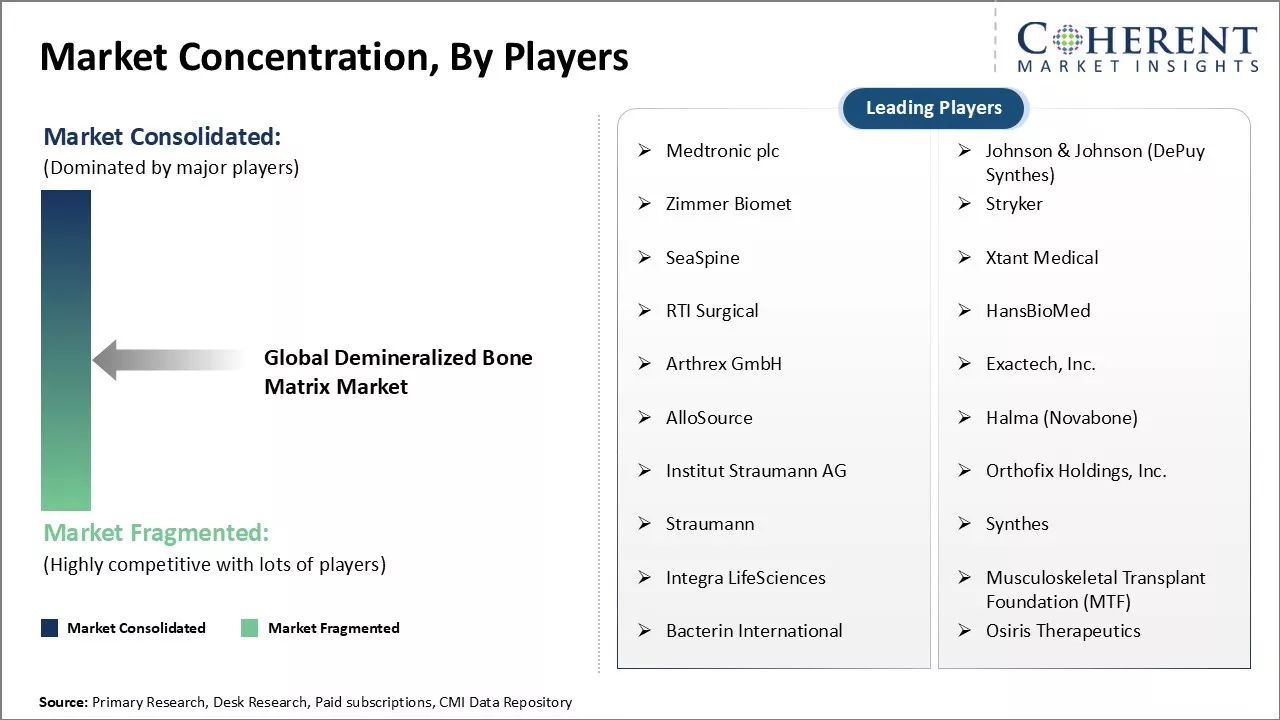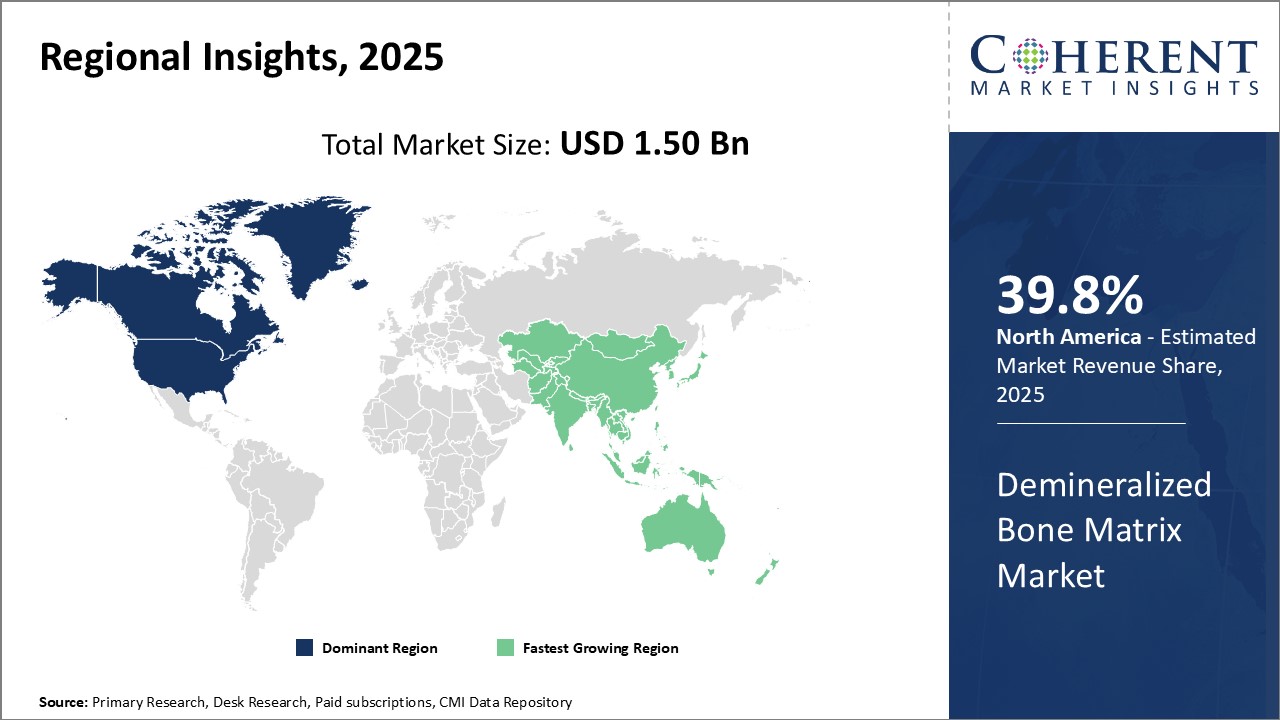
The Global Demineralized Bone Matrix Market is estimated to be valued at USD 1.50 Billion in 2025 and is expected to reach USD 2.32 Billion by 2032, exhibiting a compound annual growth rate (CAGR) of 6.4% from 2025 to 2032.

Discover market dynamics shaping the industry: Download Free Sample
The demineralized bone matrix market is expected to witness a positive growth trend over the forecast period. Rising number of sport injuries and bone and joint disorders such as osteoporosis and arthritis is expected to drive demand. In addition, increasing demand for bone graft substitutes and technological advancements in medical procedures are expected to provide new opportunities for market players. Stringent regulatory framework and high costs associated with bone grafting procedures may hamper market growth to some extent over the forecast period. However, growing elderly population prone to bone related issue will have significant impact on the demand.
Market Driver - Increasing demand for bone graft substitutes
The demand for bone graft substitutes is on a steady rise in the recent years. With increasing number of traumatic injuries, aging population and growing medical tourism industry, the number of orthopedic surgeries requiring bone grafts have seen a significant upward trend. Autografts have been traditionally considered as the gold standard for bone grafting procedures; however, harvesting autografts is an invasive procedure which causes donor site morbidity and limited graft material. This has fueled the need to explore alternative bone graft options with comparable healing properties but without the drawbacks of autografts.Demineralized bone matrix has emerged as one such favorable bone graft substitute capable of replacing autografts in many orthopedic procedures. It provides an off-the-shelf allograft material obtained from human cadaveric bone which is processed to retain only the organic components essential for bone regeneration. Without the mineral content, it resorbs slowly and promotes new bone formation. Demineralized bone matrix also carries significantly lower risk of disease transmission or immune responses unlike other allograft options. The ability of demineralized bone matrix to induce bone growth without donor site pain or constraints of material availability has made it a preferable choice for surgeons and patients alike over the past few years.

Get actionable strategies to beat competition: Download Free Sample
Rising Cases of Orthopedic Disorders and Injuries
Orthopedic conditions requiring bone grafts are on a surge worldwide. This can majorly be attributed to growing prevalence of osteoporosis, rising obesity levels and sedentary lifestyles leading to increased risk of fractures. Ageing population profile of many countries have further augmented the occurrence of orthopedic ailments. In addition, frequent traumatic injuries due to rising sports participation, urbanization and road accidents are posing a significant healthcare challenge. As per recent estimates by credible health organizations, musculoskeletal disorders already account for over 160 million disability days globally each year. With lengthening life expectancy and active ageing, orthogeriatric patients with complex osteoporotic fractures or spinal conditions are also rising fast. Developed regions are particularly impacted since osteoporosis and age-related bone fragility have reached epidemic proportions in these areas. At the same time, occurrence of injuries has doubled in low and middle-income countries according to data from past decade. All these trends collectively are driving greater demand for various orthopedic reconstruction procedures involving bone grafts on a worldwide scale. Demineralized bone matrix, with its proven integration and healing properties, is well-positioned to cater to this surging need for effective bone graft substitutes.
Key Takeaways from Analyst:
The global demineralized bone matrix market has strong growth potential driven by rising geriatric population and increasing prevalence of orthopedic diseases and injuries. As the risk of fractures and bone related issues grow with age, demand for bone graft substitutes is expected to surge. Additionally, increasing number of spinal fusion surgeries, trauma cases and advancing reconstructive therapies will propel market growth over the forecast period.
North America currently dominates the market and is expected to maintain its lead position owing to rising healthcare spending and growing adoption of bone grafting procedures in the region. However, Asia Pacific is likely to witness the highest growth rate due to rapidly developing healthcare infrastructure, growing medical tourism industry and rising incidence of osteoporosis in densely populated countries like India and China.
Along with opportunities, certain challenges like high competition from alternative bone graft solutions and stringent regulatory approval process for new products may hamper the market progression to an extent. Additionally, limited patient awareness in developing regions and high cost of bone grafting surgeries can also restrict the market growth potential particularly in price sensitive developing countries.
Product innovation through R&D and strategic collaborations to develop advanced bone graft solutions will present new revenue pockets for market players. Focus on emerging markets and increasing awareness about bone health can further expand the market outreach.
Market Challenge - High cost of bone grafting procedures
One of the key challenges for the global demineralized bone matrix market is the high cost associated with bone grafting procedures. Bone grafting is an expensive orthopedic procedure, and the costs vary depending on the type, extent of graft needed, and procedures used. Typically, an autogenously bone graft procedure can cost anywhere between US$ 10,000 and US$ 20,000. Allograft procedures are slightly cheaper but can still range from US$ 5,000 to US$ 15,000. The high costs pose affordability issues especially in developing regions where healthcare budgets are limited. This challenge restricts the ability of surgeons to opt for bone graft procedures for certain non-life threatening conditions like bone fractures and injuries where other alternative treatments may be opted. Addressing the challenge of costs would be important for unlocking the market potential in developing regions.
Market Opportunity- New Product Innovations and Launches
The global demineralized bone matrix market is expected to witness new opportunities arising from constant new product innovations and launches. Vendors in the market are investing heavily in R&D to develop advanced bone graft solutions with improved handling properties, faster incorporation time, and better clinical outcomes. Many companies are focusing on developing bone graft substitutes that can mimic the structure and properties of natural bones. Launch of synthetic bone graft materials, bone morphogenic protein formulations, and bone graft composite products are expanding the product pipeline. Such new product innovations are helping address the various unmet needs of orthopedic surgeons and patients better. They are also diversifying the portfolio of treatment options available to the clinicians. This is expected to drive the overall market revenues during the forecast period.

Discover high revenue pocket segments and roadmap to it: Download Free Sample
By Product Type- Ease of Application Drives Demand for Putty
In terms of product type, putty segment is expected to contribute the highest share of 40.5% in 2025 owing to its convenience and ease of application. Putty has a paste-like consistency which allows surgeons to effectively mold it to the defect site during surgical procedures. Its pliable texture facilitates conforming coverage of irregular defect areas which other forms may not be able to achieve. The putty also hardens upon contact with blood and bone fragments, assisting incorporation into the defect site. These properties reduce surgical time spent ensuring proper filling and fixation compared to other product types like strips or sheets. Its uniform consistency also prevents gaps or voids that could impact bone regeneration. The putty's handling properties make it suitable for both small and large defects, contributing to its popularity among orthopedic surgeons. Its wide ranging applications have captured a significant share of the demineralized bone matrix market.
By Tissue Source- Allograft Advantages Drive Superior Outcomes
In terms of tissue source, allograft segment is expected to contribute the highest share of 65.5% in 2025 due to its associated clinical advantages. Allograft uses bone tissue donated from the same species which is later processed to be acellular and decalcified. This retains natural osteoinductive and osteoconductive properties similar to a patient's own bone which supports superior bone growth compared to alternatives. Allograft elicits a lower immunological response than xenograft and does not require disease screening or harvesting from the patient, reducing surgical risks and costs. Studies have shown allograft achieves faster fusion and incorporation into defect sites than synthetic substitutes. These benefits have resulted in preference by surgeons seeking optimal fusion and healing outcomes especially for complex revisions, non-unions or high mobility cases. Accordingly, allograft has gained the most widespread adoption among tissue sources in demineralized bone matrix procedures.
By Application- Spinal Fusion Dominates due to Aging Population
In terms of application, the spinal fusion segment is expected to contribute the highest share of 40.5% in 2025 driven by the growing elderly patient demographic. Spinal fusion is a common orthopedic procedure mainly used to treat debilitating back pain from degenerative disc disease, spondylolisthesis or scoliosis. The procedure stimulates bone growth between vertebrae to restrict movement and stabilize the spinal segment. As life expectancy rises globally, age-related spinal conditions are increasing rapidly. In tandem, the demand for spinal fusion surgeries requiring grafting materials like demineralized bone matrix is surging. Moreover, obese and sedentary lifestyles are exacerbating disc issues at younger ages. With limited treatment options, spinal fusion remains the standard of care for relieving pain and improving mobility. Together, these demographic and lifestyle trends will continue propelling the spinal fusion segment to dominate demineralized bone matrix applications for the foreseeable future.

Need a Different Region or Segment? Download Free Sample
North America has been the leading region in the global demineralized bone matrix market with an estimated share of 39.8% in 2025 owing to presence of major market players and widespread adoption of bone graft substitutes. The U.S. accounts for the largest share due to availability of advanced healthcare facilities and growing elderly population suffering from orthopedic disorders such as osteoporosis. Moreover, strong reimbursement policies and high expenditure on healthcare have been contributing heavily to the market growth. Key players like Medtronic, Stryker, and J &J Medical Devices have their headquarters in the region and invest aggressively in research & development of new technologies.
Another key factor for North America's dominance is the pricing flexibility it offers to players. Manufacturers have discretion over pricing their products according to the treatment method and complexity which drives higher revenue generation. There is also a rise in medical tourism as foreign patients travel to the region for advanced bone graft procedures. Exports of bone graft substitutes from North America have increased over the years as developing nations increasingly adopt such technologies.
Among other regions, Asia Pacific market for demineralized bone matrix is witnessing fastest gains and has emerged as the most lucrative. Rapidly developing economies like China and India provide huge growth opportunities owing to their large geriatric demographic and improving healthcare expenditures. Both countries have shown significant import growth for bone graft materials to meet the increasing demand from hospitals, orthopedic centers and surgeons. With growing medical infrastructure, availability of skilled practitioners and rising patient awareness, Asia Pacific offers an attractive landscape for market players.
Demineralized Bone Matrix Market Report Coverage
| Report Coverage | Details | ||
|---|---|---|---|
| Base Year: | 2024 | Market Size in 2025: | USD 1.50 Bn |
| Historical Data for: | 2020 To 2024 | Forecast Period: | 2025 To 2032 |
| Forecast Period 2025 to 2032 CAGR: | 6.4% | 2032 Value Projection: | USD 2.32 Bn |
| Geographies covered: |
|
||
| Segments covered: |
|
||
| Companies covered: |
Medtronic plc, Johnson & Johnson (DePuy Synthes), Zimmer Biomet, Stryker, SeaSpine, Xtant Medical, RTI Surgical, HansBioMed, Arthrex GmbH, Exactech, Inc., AlloSource, Halma (Novabone), Institut Straumann AG, Orthofix Holdings, Inc., Straumann, Synthes, Integra LifeSciences, Musculoskeletal Transplant Foundation (MTF), Bacterin International, and Osiris Therapeutics |
||
| Growth Drivers: |
|
||
| Restraints & Challenges: |
|
||
Uncover macros and micros vetted on 75+ parameters: Get instant access to report
*Definition: The Global Demineralized Bone Matrix Market involves the commercial production and sale of demineralized bone matrices derived from animal or human bones. These matrices are used as substitutes or bone grafting materials for various orthopedic and dental procedures such as spinal fusion, trauma fixation, and reconstruction surgeries. They provide osteoinductive signals and osteoconductive scaffold that stimulate osteogenesis for new bone formation.
Share
Share
About Author
Komal Dighe is a Management Consultant with over 8 years of experience in market research and consulting. She excels in managing and delivering high-quality insights and solutions in Health-tech Consulting reports. Her expertise encompasses conducting both primary and secondary research, effectively addressing client requirements, and excelling in market estimation and forecast. Her comprehensive approach ensures that clients receive thorough and accurate analyses, enabling them to make informed decisions and capitalize on market opportunities.
Missing comfort of reading report in your local language? Find your preferred language :
Transform your Strategy with Exclusive Trending Reports :
Frequently Asked Questions
Joining thousands of companies around the world committed to making the Excellent Business Solutions.
View All Our Clients